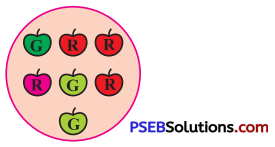Punjab State Board PSEB 8th Class Maths Book Solutions Chapter 5 Data Handling Ex 5.3 Textbook Exercise Questions and Answers.
PSEB Solutions for Class 8 Maths Chapter 5 Data Handling Ex 5.3
1. List the outcomes you can see in these experiments:
Question (a).
Spinning a wheel

Solution :
Outcomes of spinning the given wheel are :
A, B, C or D.
Question (b).
Tossing two coins together
Solution:
Outcomes in tossing two coins together are : HH, HT, TT, TH
(H = Head, T = Tail)
2. When a die is thrown, list the outcomes of an event of getting
Question (i).
(a) a prime number.
(b) not a prime number.
Solution:
Possible outcomes are: 1, 2, 3, 4, 5 or 6
Prime numbers = 2, 3, 5
(a) Outcomes of getting a prime number are: 2, 3 or 5.
(b) Outcomes of getting not a prime number are : 1, 4 or 6.
(ii) (a) a number greater than 5.
(b) a number not greater than 5.
Solution:
(a) Outcomes of getting a number greater than 5 is 6.
(b) Outcomes of getting a number not greater than 5 are: 1, 2, 3, 4 or 5.
![]()
3. Find the:
Question (a).
Probability of the pointer stopping on D in (Question 1 – (a)) ?
Solution:
There are 5 sectors containing A, B, C and D.
Since, there is only 1 sector containing D.
∴ Favourable outcomes = 1
Number of total outcomes = 5
∴ Probability of the pointer stopping on D = \(\frac {1}{5}\)
Question (b).
Probability of getting an ace from a well shuffled deck of 52 playing cards ?
Solution:
Number of possible outcomes = 52
(Total number of cards in a deck = 52)
Since, there are 4 aces in a pack of 52 cards.
∴ Favourable outcomes = 4
∴ Probability of getting an ace = \(\frac{4}{52}=\frac{1}{13}\)
Question (c).
Probability of getting a red apple. (See figure below)

Solution:
Total number of apples = 7
∴ Possible number of ways = 7
Since, there are 4 red apples.
∴ Favourable outcomes = 4
∴ Probability of getting a red apple = \(\frac {4}{7}\)
![]()
4. Numbers 1 to 10 are written on ten separate slips (one number on one slip), kept in a box and mixed well. One slip is chosen from the box without looking into it. What is the probability of.
Question (i).
getting a number 6 ?
Solution :
We can get a slip written the number ‘6’ only once.
∴ Number of favourable outcome = 1
Probability of getting the number 6 = \(\frac {1}{10}\)
Question (ii).
getting a number less than 6 ?
Solution:
Numbers less than 6 are 1, 2, 3, 4 and 5. These are five numbers.
∴ Favourable outcomes = 5
Probability of getting the number less than 6 = \(\frac {5}{10}\) = \(\frac {1}{2}\)
Question (iii).
getting a number greater than 6 ?
Solution :
Numbers greater than 6 are 7, 8, 9 and 10. These are four numbers.
∴ Favourable outcomes = 4
Probability of getting the number greater than 6 = \(\frac {4}{10}\) = \(\frac {2}{5}\)
Question (iv).
getting a 1-digit number ?
Solution :
1-digit numbers are 1, 2, 3, 4, 5, 6, 7, 8 and 9. These are nine numbers.
∴ Favourable outcomes = 9
Probability of getting a 1-digit number = \(\frac {9}{10}\)
![]()
5. If you have a spinning wheel with 3 green sectors, 1 blue sector and 1 red sector, what is the probability of getting a green sector? What is the probability of getting a non-blue sector?
Solution:
There are 5 sectors in all.
(3 + 1 + 1 = 5)
∴ Number of total possible outcomes = 3
Probability of getting a green colour sector = \(\frac {3}{5}\)
There are 4 non-blue sectors. (5 – 1 = 4)
∴ Number of favourable outcomes = 4
Probability of getting a non-blue sector = \(\frac {4}{5}\)
6. Find the probabilities of the events given in Question 2.
Solution:
There are 6 outcomes.
(i) 2, 3 and 5 are prime numbers. These are three numbers.
∴ Favourable outcomes = 3
Probability of getting a prime number = \(\frac {3}{6}\) = \(\frac {1}{2}\)
(ii) 1, 4 and 6 are non-prime numbers. These are three numbers.
∴ Favourable outcomes = 3
Probability of getting a non-prime number = \(\frac {3}{6}\) = \(\frac {1}{2}\)
(iii) 6 is greater than 5. This is only one number.
∴ Favourable outcome = 1
Probability of a number greater than 5 = \(\frac {1}{6}\)
(iv) 1, 2, 3, 4 and 5 are not greater than 5. There are five numbers.
∴ Favourable outcomes = 5
Probability of a number which is not greater than 5 = \(\frac {5}{6}\)